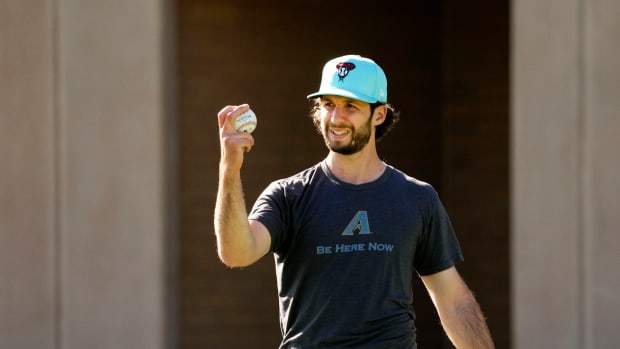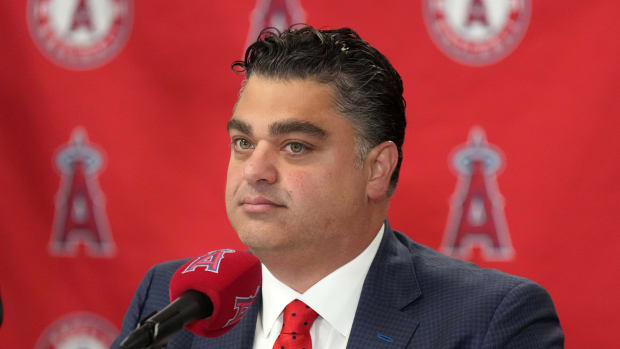Reds closer Raisel Iglesias is looking more unhittable with every outing
Raisel Iglesias broke into the majors in 2015 as a starting pitcher with a menacing fastball, biting slider, and not much else. That was enough for him to turn in a promising 95 1/3-inning debut season, posting a 4.15 ERA, 3.55 FIP, 1.14 WHIP and 104 strikeouts against 28 walks. It wasn’t a great season for the Reds, but it at least appeared they had a candidate to inherit Johnny Cueto’s mantle atop their rotation.
Iglesias was one of my favorite sleeper starting pitchers entering last season. He may have thrown fewer than 100 innings as a rookie, but it doesn’t take nearly that long to get a sense of how electric a pitcher can be. My Iglesias awakening came in a September 2015 start at Wrigley Field. Iglesias held the mighty Cubs, who would be playing in the NLCS about six weeks later, to two runs on seven hits in seven innings, striking out 10 while walking three. The proof that he was a frontline starter in the making was evident not only to me, but also to Kris Bryant and Anthony Rizzo.
Remember that Rizzo GIF. We’ll be coming back to it shortly.
The 2016 season brought an abrupt end to Iglesias’s campaign to be the Reds ace. He struggled early in the season, failing to make it into the seventh inning in any of his first five starts, and then hit the DL with a shoulder injury. When he returned two months later, he did so as a reliever, and he instantly found more success. He ended up throwing 50 innings out of the bullpen, amassing a 1.98 ERA, 3.21 FIP, 0.96 WHIP and 54 strikeouts. It was evident then, as it is now, that Iglesias found his new home.
Fenway racists messed with the wrong person in Orioles’ Adam Jones
In most situations, you want your best pitchers in the rotation for the simple reason that you want them throwing 200 innings rather than 60 to 70. Iglesias, however, has a skill set that is suited to relief work generally, as well as the budding movement in the strategy of bullpen management. Both of those facts are helping him turn into a lockdown closer, as well as the key member of Cincinnati’s bullpen, no matter when he takes the mound.
These are the two separate prongs that are turning Iglesias into a great weapon for manager Bryan Price. Iglesias has made nine appearances this season, pitching to a 1.26 ERA, 2.72 FIP and 0.84 WHIP with 16 strikeouts across 14 1/3 innings. Let’s begin with Iglesias being particularly cut out for relief work. Remember that GIF against Rizzo? Don’t worry, there’s no reason to scroll up. I’ll drop it in again right here.
That’s 94 mph at the letters against one of the league’s premier left-handed hitting mashers. Rizzo hit .278/.387/.512 with 31 homers that year and finished fourth in NL MVP voting, and Iglesias blows his four-seamer right past him. That’s the pitch that has helped bring Iglesias game to another level this season.
During his first two years in the league, Iglesias used his sinker as frequently as his four-seamer. Last year, in fact, he used the former more often, throwing it 37.8% of the time, compared with a 23.8% usage rate for his four-seam fastball. This season, Iglesias has flipped the ratio, and then some, with his four-seamer climbing to 41.1% usage, and his sinker down to 15.4%. The results have been predictable.
As Manny Machado's talent and production grow, so does his earning power
Hitters have put 17 of Iglesias’s four-seamers in play this season. Four of them resulted in hits, all of which were singles. Nearly half of his four-seamers have been strikes, including seven whiffs, good for a respectable 8% whiff rate. Freed from the necessity of saving bullets for his sixth or seventh inning of work, Iglesias has seen his average four-seam velocity jump to 96.4 mph this season, which would be a career high if it holds all year. The pitch also does an excellent job of setting up his wipeout slider, which has a whiff rate of 29.6%. The combination of the two pitches is what makes Iglesias a special reliever.
First, the fastball. Sorry, Howie Kendrick, we’re going to need to use you for this demonstration. Don’t worry, though. It’s not like many, if any, hitters in the majors could have done much with this pitch.
That’s 97 mph on the black, in the strike zone, on a 2–2 pitch. Kendrick can’t lay off, but he’s not going to do much if he makes contact on that pitch. In a word, it’s perfect. Two days later, Kendrick’s teammate, Tommy Joseph, got the Iglesias treatment. He, however, gives us our first look at the fastball and slider working together. First, Iglesias burned Joseph with a 97-mph heater.
It doesn’t much matter that this pitch is inside when Iglesias wants it outside. You can get away with missing your spot when you throw 97. Now, with that in Joseph’s mind, Igelsias breaks off a slider two pitches later. The result is all too easy to see coming.
Thanks for playing, Tommy.
Maybe you’re not that impressed with a pitcher striking out a Joseph. That’s cool, I get it. Perhaps you’d prefer to see Iglesias strike out Manny Machado? We’ve got that for you, too.
I call this A Slider Turning a Monster into a Helpless Flailing Puddle: A story in three GIFs.
I will readily admit that I have not seen every single swing Machado has taken in his career. Still, I feel comfortable betting that the strike three swing Machado got out of him was the single worst swing of his career. When a pitcher gets a hitter of Machado’s caliber to chase a 1–2 slider that bounces just beyond the opposite batter’s box, you know he is in total control. To have that sway over a hitter like Machado should tell you what kind of closer Iglesias already is in his first full year shutting games down for the Reds.
What’s notable, too, is that while Iglesias is the Reds closer, he has entered the game in the ninth inning in just two of his nine appearances, and those were his first two of the season. Iglesias has taken the mound in the eighth six times this season, and once in the fifth. In that one, Price called on his closer in a tie game against the Brewers with Eric Thames, Ryan Braun and Domingo Santana due up. Iglesias pitched the fifth and the sixth, and while he surrendered a home run to Hernan Perez, it put on display Price’s willingness to use his best reliever in the game’s most important situations, regardless of when they arise.
That Price trusts him for multiple innings is a great development for his fantasy value. You know what’s better than, say, 65 innings of elite rate? Eighty innings of elite rates. Iglesisas will likely throw more innings than the typical closer this season, given how Price is deploying him, and that means his top-tier rates will go further than most of his ninth-inning brethren. He may not be a starter, and this might be a year later than expected, but Iglesias is turning into a breakout star.


































